The team "Granular materials and Suspensions" develops a mainly experimental work on the one hand on fundamental problems of rheology of these materials, on the other hand on natural or technological situations in which these materials are involved. The rheological studies concern both the dry grains for which the interactions are made by solid contacts and the suspensions of particles for which the interactions are also of a hydrodynamic nature via the carrier fluid. The influence of the interstitial fluid is, for example, important in the elementary process of collision between grains or grains with the walls, but also in the development of differences of normal stresses under shear or else in the phenomena of migration and particle structuring. Of particular interest is the study of dense regimes, close to the blocking transition or "jamming", separating a "fluid" state from a "solid" state.

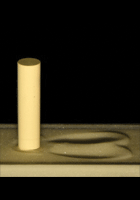
Scour around a bridge pier
Sediment erosion and transport phenomena may represent a significant threat to human activities, infrastructure and ecosystems. For example, around a bridge pier or offshore platform, erosion can damage the structure and cause its collapse. Despite the risks, a physical description of the erosion phenomenon in the vicinity of structures remains incomplete to this day, especially the coupling between fluid dynamics and transport of solid particles is not well quantified. We study this phenomenon to characterize the particle dynamics in the presence of a flow in the vicinity of one or more immersed obstacle(s).

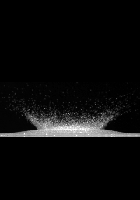
Impacts in a granular medium
We study the dynamics of penetration of a projectile by impact or by successive impacts in a granular medium.

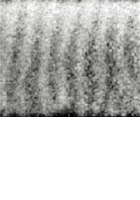
Structuration of a particle suspension oscillating in a Hele-Shaw cell
Time dependent motions of particle suspensions occur in many natural (e.g. seabeds) and industrial flows. We have shown that the concentration of a suspension of non Brownian iso-dense particles oscillating between transparent parallel plates may vary spatially in the direction parallel to the flow, giving rising to periodic transverse streaks. The analysis of the particle distribution in the aperture of the cell shows that there is first a segregation of the particles into a plane layer in the center of the aperture which becomes wavy and, then, the periodic structure appears.

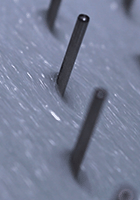
Granular avalanches in the presence of obstacles
We experimentally study the influence of a forest of obstacles on the avalanche process of a layer of grains on an inclined plane. A model taking into account the resistance of the pillars on the movement of the grains makes it possible to predict the decrease in flow observed experimentally. This work is a first step for the dimensioning of devices for preventing the risks associated with snow avalanches or rock slides, for example.

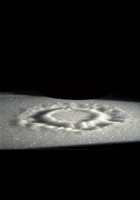
Propulsion in the vicinity of a granular media
We are interested in the particles resuspension by some flatfish, as soles or lines, capable of generating a flow allowing resuspension of sand to bury and avoid predators. Beating fins with oscillating movements, these fish create vortices that raise the sand and deposit them on their back. Here, a rigid or flexible disk is placed on top of a granular bed to mimic the movement of the fins.

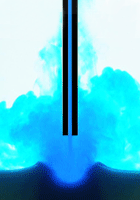
Jet erosion
We are interested here in the erosion of a granular medium by a jet, circular or plane, in laminar or turbulent regimes. We are interested in both the fine characterization of the erosion threshold and the morphology of craters beyond the threshold, taking into account the complex hydrodynamics of the jet, and lately the possible cohesion of the granular medium.

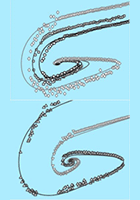
Collision of fluid immersed grains
The collision of a sphere with a solid wall immersed in a fluid is studied with an interferometric technique to solve the collision process in time (resolution 2 μs) and space (resolution 0.2 μm). The influence of roughness on the collision process is characterized by using controlled microtexture walls. The rebound or not of the sphere can be characterized according to the number of Stokes of collision and the geometric and elastic characteristics of the wall. The detailed modelling of hydrodynamics makes it possible to highlight the viscous dissipation occurring during the collision process.

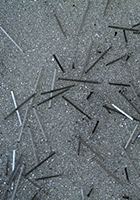
Grains and fibers
The addition of a small amount of fibers to a granular medium is known to significantly enhance its mechanical strength. In the laboratory, we are studying the influence of fibres on the macroscopic behaviour of granular media in various flow configurations and seeking to describe the physics of the underlying coupling between grains and fibres.

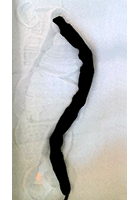
Locomotion in granular media
We are interested in the locomotion strategies employed by animals that move in sand, such as snakes, lizards and cockroaches. We are developing bio-inspired robots to study the interaction between the animal's movement and the granular material. The aim is to understand the physical constraints that govern the movement of these animals in the sand.


Tsunami generation by granular collapse
Landslides or cliff collapse can generate tsunamis that can lead to serious damage to coastlines and major risks for neighboring populations. A quasi two-dimensional experiment is used to study the generation of the waves produced by a granular collapse in a fluid layer (here in green). The influence of the grains (size, shape, etc.) and the water depth on the wave produced is studied by image analysis.

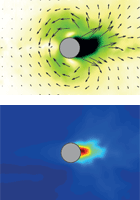
Local rheology in the granular flow around an intruder
The rheological properties of granular matter within a two-dimensional flow around a moving disk is investigated experimentally. The strain and stress tensors are estimated at the grain scale in the time-averaged flow field around a large disk pulled at constant velocity.






